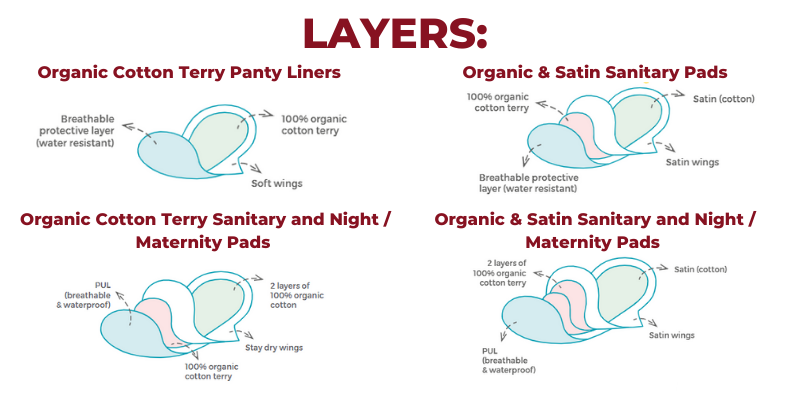We compiled all the questions we regularly get about reusable sanitary pads and panty liners and answered them in this article. What’s the difference between sizes and fastenings, how to store used pads, is it hygienic? Can you find your own question? We compiled all the questions we regularly get about reusable sanitary pads and panty liners and answered them in this article. What’s the difference between sizes and fastenings, how to store used pads, is it hygienic? Can you find your own question?
The most frequently asked question we get almost on a daily basis: Washing reusable pads and liners, their maintenance, their storage. How to wash and store used reusable pads and panty liners?
We already have a very thorough article on this topic, so please be so kind and redirect yourself here: How to wash reusable sanitary pads and panty liners. This article contains all the information on washing, storing, and drying of reusable pads, will tell you how to prevent stains and it even answers one of the most burning questions: Don’t used pads smell bad? (Hint: No, they don’t!)
How to prevent stains on reusable pads and panty liners?
This question is also answered in our How to wash reusable pads and panty liners article—we recommend checking it out!
In short: Store used pads and liners without water (don’t add any) and let them breathe (unfold them) during storage. Prior to washing, let your used pads soak in ice cold water for a few hours. This will dissolve the haemoglobin which might colour your pads for good (mixing haemoglobin with warm water will stain your pads irretrievably).
On this note, we would like to add that stains don’t mean that your pads aren’t hygienic! They’re absolutely clean, it’s just that the haemoglobin has coloured the fibres of the textile fabric. It’s only colour, not dirt or anything like that. Stains are not really a problem, in our book. No one will see them apart from you, anyway.
How many reusable pads do I need to get me through my period?
Good question! However, there’s no universal answer to it. We can’t say „You’ll need approximately XY pads per one menstrual cycle“—the length and heaviness of one’s period is very individual.
We can, however, provide with some guidance: Absorbing capacity of reusable pads and panty liners compares to their disposable counterparts. So, here’s a general rule for you: You’ll most likely need as many reusable pads as you would need disposable pads.
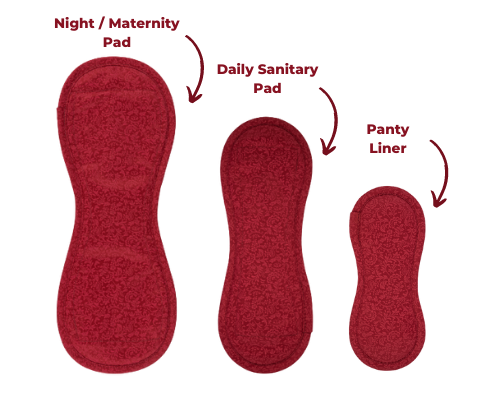
What is the difference between sizes of reusable pads and panty liners?
We offer three sizes of reusable pads/panty liners, the smallest being panty liners, our sanitary pads are middle-sized and our night/maternity pads are the biggest. How to combine these sizes?
- Panty Liners are the best choice for days with a light menstrual flow. They can also be used as a back-up to your menstrual cup or they can be used on daily basis if you use panty liners every day. They also work well for people with light/stress incontinency (bearing in mind that their bottom layer is only water-resistant, not waterproof just as with our day or night pads; on the other hand, this also means they are more breathable).
- Sanitary Pads are ideal for the first days of your period when your bleeding is the heaviest. They’re perfect also for incontinency problems.
- Night/Maternity Pads are designed as reliable pads for the night or for the postpartum period. They’re really big and really absorbing. However, it should be said that not everyone needs a night pad! Some bleed a lot at night when on their period but then there are others whose night bleeding is lighter than their bleeding during the day—those can safely use a regular sanitary pad at night and be OK.
Our reusable pads and liners according to their size and absorbing capacity:
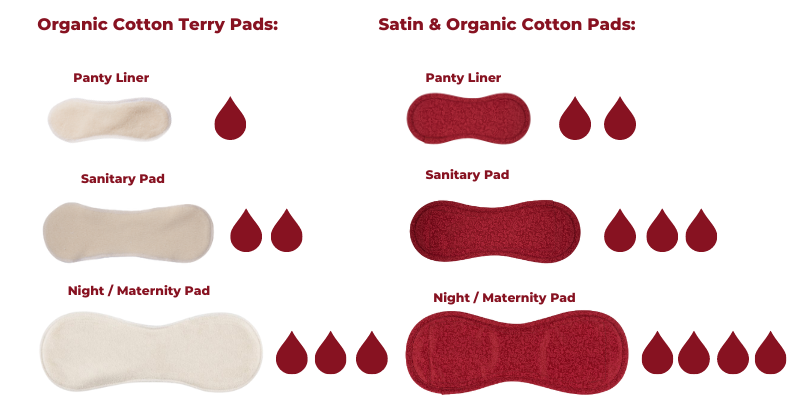
What is the difference between reusable pads from organic cotton terry and the satin ones?
Besides their colour which is obvious at the first glance:
- Satin pads have one more layer inside, which makes them more absorbing.
- Satin panty liners and satin sanitary pads are slightly bigger than their counterparts from organic cotton terry (this is not valid for night/maternity pads which are the same in size).
- Satin sanitary pads and panty liners hold their shape better, on the other hand organic cotton terry is softer to touch and material is more flexible.
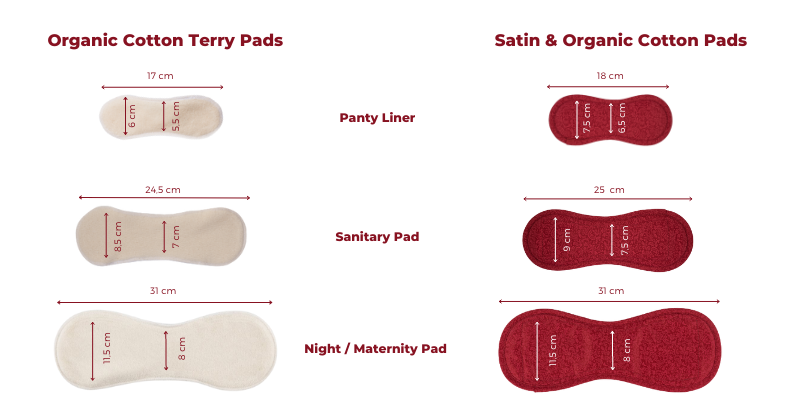
What is the difference between snap and velcro fastenings?
This short video gives you a quick idea.
Fun fact: The requirement to make reusable pads and panty liners with velcro fastenings came from the Netherlands. Why? Because cycling :-) Velcro fastening is simply flatter and not so firm, you barely feel it, even when riding a bike. Our snaps are especially flattened but still—they’re firmer than velcro.
Otherwise, there’s no functional difference between the two fastenings. We in Bamboolik team agree that velcro fastenings work great with jeans or generally pants, while when wearing stockings or going barelegged in summer, we prefer snap fastening.
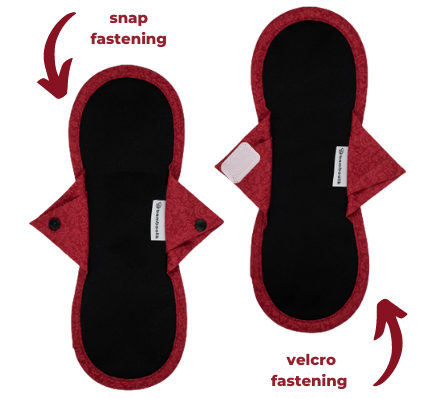
What about reusable pads at night? Can I use a regular sanitary pad for the night?
From our experience, there are vast differences in this area. Some barely bleed at night; some’s bleeding is the heaviest during their nightly rest. If you belong to the first group, you’re lucky :-) and you’ll be most likely just fine with the same reusable pad you use during the day (and if your first steps after waking up lead to the toilette, your nightly pad might even be spotless). If you belong to the second group of the less lucky ones, you need something more absorbing and bigger for the night. Check out our night pad (that can also serve as a maternity pad)—it’s greatly absorbing and we made it longer both at the front and in the back so that it doesn’t matter whether you prefer to sleep on your back or on your stomach.
Breathability of reusable pads is the asset that you will most likely appreciate the most at night—you’ll be wearing the pad for hours. Disposable sanitary pads can never compare to reusable ones when it comes to breathability.
Can I use reusable pads as maternity pads for the postpartum period?
But of course, great choice! We offer two types of maternity pads, either from organic cotton terry (softer and more flexible fabric) or with satin contact layer (these are our most absorbing pads among all).
To be honest, we don’t expect you to care about reusable pads when having your hands full with your newborn baby. Being on disposable maternity pads for a few days won’t cause an environmental catastrophe!
Approximately after the first postpartum week, your bleeding will start resembling your regular menstrual flow and will get lighter every day. This is the right time for our maternity pads.
For the second half of the postpartum period, regular sanitary pads might be enough or you may even switch to just panty liners (both of which are a good use of money as you will be able to use them when your regular period comes back).
Same as for the night, reusable pads are a great choice for the postpartum period due to their breathability. Moreover, the contact layer is made of soft cotton—they feel like regular underwear, not a piece of strange fabric in your pants.
Do reusable sanitary pads and panty liners stay in place? Don’t they move in your underwear?
No worries! All our sanitary pads and panty liners have wings that secure the pads in its place in your underwear. They don’t move or slip, they stay where they should stay.
Are reusable sanitary pads really reliable?
Absolutely! Absorbing capacity of reusable pads is the same (if not higher) than absorbing capacity of disposable pads. All our reusable sanitary pads and panty liners have organic cotton absorbent inside and absorb liquids really fast. Especially with our satin pads, we often get asked whether liquids don’t take time to get absorbed—no, they don’t! We understand where this worry is coming from as some might think that „satin“ is a very shiny, very smooth and very not natural fabric but that’s not true. „Satin“ is a type of weave that can be used for any fibres—and we use cotton. So, our satin is 100% cotton, very soft and also very absorbing.
The reliability of satin pads is furthermore secured by a satin hem around the body of the pad (or the panty liner) which stops any potential leak from getting out, making the blood stay in the middle of the pad.
Another great feature that makes our reusable pads and liners very reliable, are their wings! They secure the pad in your underwear, thus stopping it from moving around. Moreover, our wings are sewn on the body of the pad, our pads are not cut from one piece of fabric, wings included (as is the norm with a lot of reusable pads). This also means absolutely nothing leaks onto the wings.
Curious about water-resistance? Our sanitary pads and night/maternity pads have a layer from PUL (laminated polyester) on the bottom. It’s the layer that should touch your underwear (layer farther from the body). PUL is a membrane-like material that is waterproof but still breathable. Will keep you safe even during your heavy bleeding days. (Our panty liners don’t have a PUL layer, they have soft polyester layer instead. It’s not 100% waterproof but doesn’t absorb any liquids. Which is sufficient for panty liners, they don’t need an extra waterproof layer.)
How absorbing are reusable sanitary pads and panty liners?
Reusable pads compare to disposable ones, they may even outperform them as their absorbing capacity is very high and they absorb liquids immediately. However, this doesn’t mean they’re big! They’re still very thin, you’ll barely know that you’re wearing them. Our night/maternity pad being the only exception—but who expects their night/maternity pads to be not noticeable (their disposable counterparts aren’t super discrete, either). Compared to disposable maternity pads, reusable maternity pads are actually super thin.
Do I save money with reusable pads?
But of course! The initial investment into your reusable pads stash will be higher but this stash will last for years! Also, there’s no need to buy the entire stash at once, you can split your cost in months, try out different types and sizes and choose what fits you the best.
If you plan to buy multiple pads at once, check out our Bulk sale on our satin pads.
What fabric you use to make your reusable sanitary pads and panty liners? I care what I put in my underwear :-)
Our reusable sanitary pads and panty liners are made of 100% certified organic cotton of European origin. This certification stands for the best of the best of organic cotton—it is forbidden to use herbicides, pesticides and other potentially harmful chemicals during cotton farming, the use of chemicals is strictly regulated during the manufacturing process, the soil in the farming area can’t be exploited and all the workers involved in the process are being paid fair wages and are have decent working conditions guaranteed.
Our organic cotton is of European origin and our pads and liners are sewn in the Czech Republic, the heart of Europe, as we like to call it. We strive to be as local as possible.
Are reusable sanitary pads hygienic?
Without any doubts. Menstrual blood itself is sterile. Imagine you have a nosebleed and it stains your shirt—it doesn’t smell, rot or become “unhygienic“. Blood may have a slight iron-like smell to it but when aired, it dries and is absolutely odourless. The only potential problem that might occur is when used pads are stored rolled up and in an air-tight container/bag. That might prevent the blood from drying and it might start to decompose. That’s why we recommend storing used pads flat and with sufficient amount of air getting to them.
How long do reusable sanitary pads and panty liners last?
For a long time! To be honest, we don’t know exactly how long they’re going to last, we have not come to the end of their longevity yet. We always thoroughly test our products before we start selling them, either on our children (diapers) or on ourselves (reusable pads and panty liners). We have been selling reusable pads for a few years now and we still use the first samples we made back in 2018. So, we can say with ease that our pads last years, maybe even decades, we’ll see.
Don’t reusable pads rustle when you walk?
We understand this worry especially when it comes to pads with PUL as the waterproof layer (it rustles slightly when you put it between your fingers). Also, some period pants are slightly noisy, especially the more absorbing types. But our pads are silent, we promise :-)
Doesn’t a used reusable pad/panty liner smell bad in your bathroom or in your bag?
Not at all! As we already mentioned, blood itself is odourless, it has a slight iron-like smell but that disappears when it dries. Yes, used disposable pads smell and the smell is not very pleasant. But that’s due to chemicals (perfumes and artificial absorbents) in them, it’s not the blood’s fault.
And in case you want to say that you disagree, that your menstrual blood does smell bad, hold the thought. And call your OB to get yourself an appointment ASAP. Smelly menstrual blood might occur but it’s not normal, it’s a problem and it should be medically addressed.
Regarding storing used pads at work or when out and about. We highly recommend to use a PUL wetbag for them which is waterproof and breathable at the same time.
Isn’t satin too plastic a fabric?
No it’s not! We get where this idea comes from as a lot of us think of satin as a smooth, shiny and artificial fabric. Our satin is nothing like that. Satin is a type of weave—you can weave any fibres to make satin. We use 100% cotton which makes our pads soft and smooth to touch but is still very absorbing and 100% natural.
Aren’t reusable pads too bulky? Don’t they show through clothes?
Not at all. Reusable sanitary pads are not much thicker than the fabric of your underwear. Its size is pretty much the same as the size of disposable pads.
Which pads are suitable for young girls?
Cloth sanitary pads and panty liners are a great choice for girls who have just started to menstruate. They’re breathable, their contact layer is 100% cotton and they feel like regular (comfortable) underwear. Inner menstrual items might be a bit of a stress for young girls to use (that’s why we wouldn’t start with a menstrual cup which requires some experience to be put in correctly). Cloth pads and liners are the easiest to use.
Isn‘t snap fastening too firm, isn’t it uncomfortable?
Certainly not during regular activities; you can sit, walk, run and not feel your pad at all. However, you might prefer velcro fastenings when riding a bike and during similar activities (we think that’s why our velcro pads are a best-seller in the Netherlands :-)).
How does your sale on reusable satin pads and panty liners work?
It’s easy—if you buy two or more sanitary pads or satin panty liners sold by 1 piece, we give you a discount depending on how many pieces you buy (5 pads = 5% discount, 10 pads = 10% discount and so on up until the maximal 25% discount). Your discount will deduct automatically from the total price in your cart. More in the description of our discount on sanitary pads.
How to insert a reusable pad in my underwear?
Satin pads should be placed in your underwear the satin (printed) side up. Satin is the contact layer, the monochromatic (PUL) side should be touching your panties.
Organic cotton terry pads should be inserted in your underwear terry side up (the fluffy one), your panties should be touched by the PUL side for sanitary pads (PUL rustles lightly when touched) or fleece side (for panty liners).
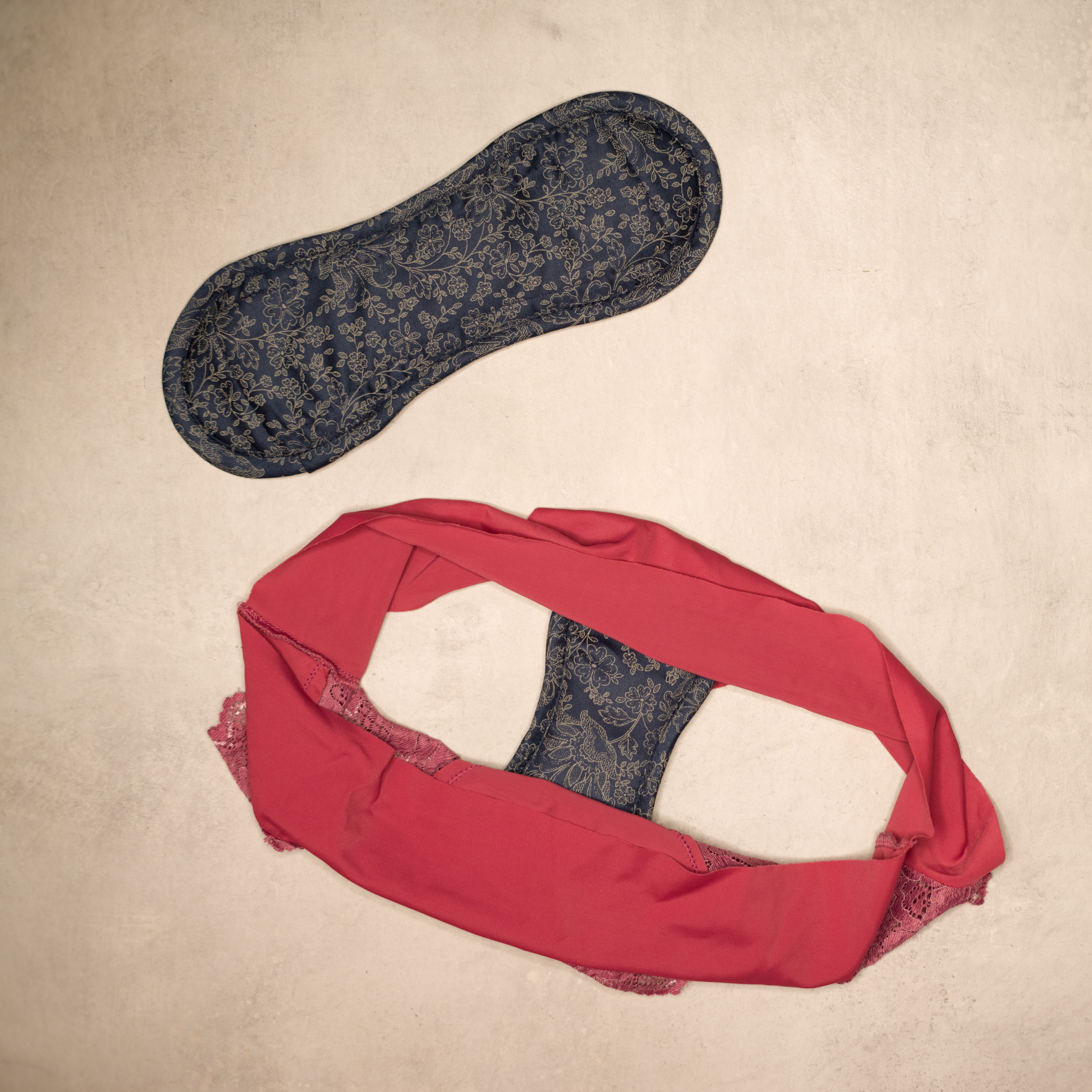
And this is it for today—these are the most repeated questions we get about reusable sanitary pads and panty liners. If you didn’t find your question here, feel free to contact us, we’re here for you! Use the chatbox here on our web or drop us a line or call us.

